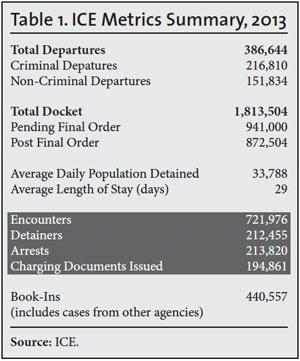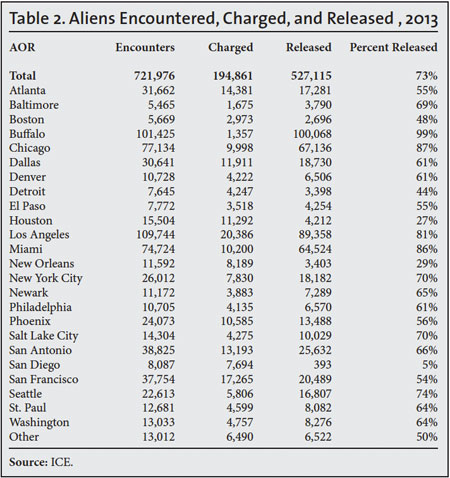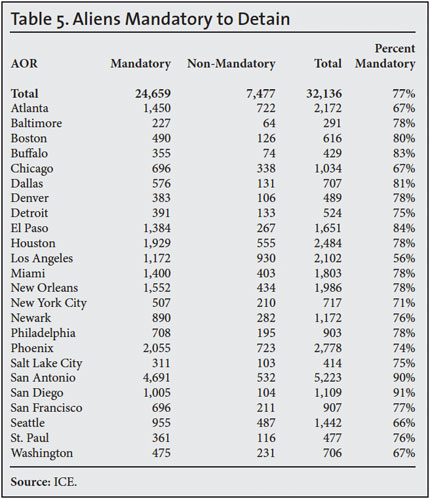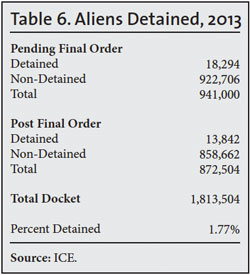Download a PDF of this Backgrounder
Read a response to critics of this Backgrounder
Jessica M. Vaughan is the Director of Policy Studies at the Center for Immigration Studies. She would like to thank Zack Nunez for research assistance.

Summary
A review of internal ICE metrics for 2013 reveals that hundreds of thousands of deportable aliens who were identified in the interior of the country were released instead of removed under the administration's sweeping "prosecutorial discretion" guidelines. In 2013, ICE reported 722,000 encounters with potentially deportable aliens, most of whom came to their attention after incarceration for a local arrest. Yet ICE officials followed through with immigration charges for only 195,000 of these aliens, only about one-fourth. According to ICE personnel, the vast majority of these releases occurred because of current policies that shield most illegal aliens from enforcement, not because the aliens turned out to have legal status or were qualified to stay in the United States.
Many of the aliens ignored by ICE were convicted criminals. In 2013, ICE agents released 68,000 aliens with criminal convictions, or 35 percent of all criminal aliens they reported encountering. The criminal alien releases typically occur without formal notice to local law enforcement agencies and victims.
These findings raise further alarm over the Obama administration's pending review of deportation practices, which reportedly may further expand the administration's abuse of "prosecutorial discretion". Interior enforcement activity has already declined 40 percent since the imposition of "prosecutorial discretion" policies in 2011.1 Rather than accelerating this decline, there is an urgent need to review and reverse the public safety and fiscal harm cause by the president's policies.
Key Findings
- In 2013, ICE charged only 195,000, or 25 percent, out of 722,000 potentially deportable aliens they encountered. Most of these aliens came to ICE's attention after incarceration for a local arrest.
- ICE released 68,000 criminal aliens in 2013, or 35 percent of the criminal aliens encountered by officers. The vast majority of these releases occurred because of the Obama administration's prosecutorial discretion policies, not because the aliens were not deportable.
- ICE targeted 28 percent fewer aliens for deportation from the interior in 2013 than in 2012, despite sustained high numbers of encounters in the Criminal Alien and Secure Communities programs.
- Every ICE field office but one reported a decline in interior enforcement activity, with the largest decline in the Atlanta field office, which covers Georgia and the Carolinas.
- ICE reports that there are more than 870,000 aliens on its docket who have been ordered removed, but who remain in defiance of the law.
- Under current policies, an alien's family relationships, political considerations, attention from advocacy groups, and other factors not related to public safety can trump even serious criminal convictions and result in the termination of a deportation case.
- Less than 2 percent of ICE's caseload was in detention at the end of fiscal year 2013.
- About three-fourths of the aliens ICE detained in 2013 had criminal and/or immigration convictions so serious that the detention was required by statute. This suggests the need for more detention capacity, so ICE can avoid releasing so many deportable criminal aliens.
Unless otherwise noted, the data for this report are from the 2013 fiscal year-end edition of ICE's "Weekly Departures and Detention Report" (WRD), which is prepared by the Information Resource Management Unit of ICE's Office of Enforcement and Removal Operations (ERO).2 This report compiles a variety of ICE caseload statistics, including encounters, arrests, detention, and removal of aliens. The tables in this report use data taken directly from the WRD.
ICE Agents Catch and Release Aliens on a Massive Scale
Table 1 summarizes key metrics on ICE's caseload. Notably, only a fraction of the cases on ICE's docket are actually deported in any given year. The departures figure, about 387,000, includes all forms of deportation, including formal removal and voluntary return,3 and counts all cases that land in ICE custody for some reason, regardless of which agency made the arrest. In 2013, about two-thirds of the departures reported by ICE were the result of a Border Patrol arrest.4

The Obama administration and anti-enforcement activist groups have tried to portray the number of departures as "record-breaking" and indicative of robust immigration enforcement. They have tried to support this claim by showing that the number of departures credited to ICE is higher than ever before. However, an independent analysis of ICE records obtained in a lawsuit showed that ICE was able to achieve these "record" departures only because the agency was taking credit for removing a large number of individuals who were apprehended by the Border Patrol. Such cases made up the majority of ICE's reported deportations in 2013, but they had never been counted that way in previous administrations.5 Although former DHS Secretary Janet Napolitano denied that the ICE reports on her watch were misleading, her successor, Jeh Johnson, recently admitted to a House committee that the administration's deportation figures are not comparable to previous administrations because of the large number of border removal cases.6
In the context of other key metrics reported in this document, the number of departures recorded by ICE is unimpressive and concerning. A more accurate picture of the state of interior enforcement can be found in the set of four metrics that relates directly to interior enforcement and the work of ICE agents and officers in the Enforcement and Removal Operations (ERO) division of ICE: encounters, arrests, detainers and charging documents Issued. These are found in the shaded part of Table 1.
In 2013, ICE officers reported about 722,000 encounters with aliens, meaning the alien was questioned, fingerprinted, or otherwise screened about immigration status, most often in a jail setting, or possibly as part of an enforcement operation, but always as the result of an actionable lead. In most cases these leads come from local jails or vetted identifications through ERO's Criminal Alien and Secure Communities programs. In the last several years, these programs have produced record numbers of encounters for ICE agents and officers, even as the number of aliens charged has declined.
Yet out of these 722,000 encounters with illegal and criminal aliens reported in 2013, ICE agents filed charges against only 195,000, or 27 percent, of the aliens. While some of the remaining 73 percent of aliens encountered might be the subject of detainers for future charges, and a small number may have turned out not to be amenable to deportation, most of the other illegal aliens were simply ignored. According to ICE personnel, the vast gap between the number of encounters reported and the number of aliens put on the path to removal exists because officers are not permitted to file charges against aliens who do not fall into the administration's narrowly defined criteria for enforcement, regardless of the criminal charges or the circumstances in which the alien was identified. Under current policies, an alien generally must have serious criminal convictions, prior deportations, or immigration violations before an officer can move to deport them. These constraints have led to a 40 percent decline in interior ICE arrests since the first "prosecutorial discretion" policies were implemented in June 2011.
Note that even as ICE moved to deport roughly 200,000 aliens from the interior in 2013, ICE booked more than 400,000 aliens into custody (detention). The difference between the two figures reflects the number of Border Patrol and other agency cases that are referred to ICE custody for processing. These cases show up in ICE's metrics as a departure and in Border Patrol or CBP metrics as an apprehension.
Finally, Table 1 shows the shocking number of cases on ICE's docket — 872,000 as of the end of the 2013 fiscal year — who had received final orders of removal, but who had not yet departed. Cases are counted in this category after all due process has been exhausted. There are therefore hundreds of thousands of alien fugitives in the United States right now who have been ordered removed and ignored those orders. While a few thousand of these are aliens who cannot be removed because they refuse to cooperate in obtaining travel documents or their home countries will not accept them, the vast majority are illegal aliens who have absconded from immigration hearings, an offense similar to contempt of court. The administration has indicated it is considering an executive action to forbid ICE from taking action against these individuals, rationalizing that these are mere immigration offenses.7
Table 2 provides details on encounters and charging documents issued broken down by ICE Field Offices. The Buffalo and Los Angeles field offices logged the greatest number of encounters, but the San Diego, New Orleans, and Houston field offices show the largest percentage of charging documents issued out of all encounters. The field offices with the worst ratio of encounters to aliens charged were Buffalo, Chicago, Miami, and Los Angeles.

Despite High Encounters, 28 Percent Fewer Aliens Targeted in 2013
A comparison of the number of charging documents issued in 2012 and 2013, shown in Table 3, reveals that despite the high number of encounters, significantly fewer illegal and criminal aliens were targeted by ICE last year. Overall, 28 percent fewer aliens were charged in 2013 compared to the previous year. These numbers do not include cases initiated by the 287(g) partnership program, in which some local officers have the authority to initiate deportations.

Every ICE field office except Buffalo experienced a decline in the number of aliens targeted for deportation. The largest decline in enforcement was in the Atlanta field office, which covers Georgia and the Carolinas. The Salt Lake City, DC/Virginia, and Houston field offices also saw larger than average declines.
ICE Released One-Third of Criminal Aliens Located
One way ICE tracks its caseload is according to criminality. Aliens are classified as "criminal" if they have been convicted of a crime, not including traffic offenses. Any alien lacking a conviction, even if there are criminal charges that have not yet been resolved, is classified as "non-criminal". Table 4 provides a breakdown by ICE field office of criminal alien encounters and charging documents issued.

In 2013, ICE agents reported encountering 193,000 criminal aliens — yet they targeted only 125,000 of these criminal aliens for deportation, letting off 68,000, or 35 percent of the total. The ICE field offices with the largest ratios of criminal releases were San Antonio, New York City, DC/Virginia, and Newark (N.J.).
These figures suggest that despite claims of a focus on public safety, the administration's prosecutorial discretion criteria are allowing factors such as family relationships, political considerations, or attention from advocacy groups to trump criminal convictions as a factor leading to deportation.
For example, the prosecutorial discretion directives issued by ICE headquarters instruct officers to release illegal aliens if the alien is a parent or caregiver, if the alien claims to be in school, if the alien has been here a long time, or if the alien claims to be eligible for the Deferred Action for Childhood Arrivals (DACA) program, among other factors.8 If an alien is found to have applied for legal status, protocol requires the deportation charges be put on hold, and the benefits application may be expedited, presumably to spare the alien the consequences a criminal conviction might have on the alien's eligibility for the legal status.9 In addition, ICE agents and officers have been instructed to ignore convictions for state crimes if the conviction occurred under a state law that the administration opposes or thinks is too harsh. Finally, many criminal aliens have been released from ICE custody, received case continuances, and sometimes even case dismissals as a result of petitions, protests, and vigils staged by illegal alien advocacy groups.
One locality that has been specifically targeted by ICE for politically motivated prosecutorial discretion is Maricopa County, Ariz. ICE attorneys in the Arizona field office reportedly are required to terminate deportation cases in which illegal aliens have been convicted of felony identity theft, which is a "crime involving moral turpitude" that requires mandatory detention and should cause the alien to be removed. Reportedly, some of these illegal aliens also have managed to qualify for DACA, despite convictions for crimes that defrauded the state and federal governments and caused severe problems for the victim of the theft. Some of the illegal aliens benefitting from ICE's failure to enforce the law are also active in local advocacy groups demanding a halt to deportations.
The release of so many convicted criminals back into U.S. communities, when they could be removed to their home countries, is a large-scale abuse of authority that inevitably leads to public harm. There is no possible excuse or logical argument, and certainly no legal justification, for failing to deport tens of thousands of aliens with criminal convictions who have been encountered by an ICE officer. ICE has claimed it lacks the resources to deport more aliens than it has for the last several years, but it has yet to explain why it has used these resources primarily to detain and process individuals apprehended by the Border Patrol, whom the Border Patrol could remove, instead of deporting criminal aliens discovered by ICE officers in the interior. Instead, the administration has repeatedly asked Congress to give it less money for detention. This year the president's budget requests a reduction of $255 million in funding for detention space for ICE, even though they are not now maintaining custody of every alien whose detention is required by law, nor every alien who poses a risk to the public or is a flight risk.
We know from experience and from empirical evidence that releasing illegal aliens who have already been involved in crime leads to more crime and more victims. This phenomenon was quantified in 2012 in a report commissioned by the House Judiciary committee. This analysis found that 26,000 illegal aliens who were released instead of removed went on to commit another 58,000 crimes soon after release. These additional crimes included 59 murders, 21 attempted murders, more than 4,000 major felonies and other 1,000 other violent crimes.10
Only a Tiny Share of ICE Cases Are in Detention
Table 5 shows the number of aliens who were in ICE detention as of the date of the report. Just over 32,000 people were being held by ICE at that time. Table 6 shows that this population is a tiny fraction (1.8 percent) of the total ICE caseload of more than 1.8 million cases, which helps explain why there is such a large number of post-final order cases who have not departed. It is not a priority for ICE to locate them, and with interior enforcement in abeyance, there is little incentive for them to leave on their own.


More than three-fourths of these individuals are in detention because their immigration and/or criminal violations are so serious that their detention by ICE is mandatory under statute, without possibility of bond. These offenses include: serious felonies, crimes of moral turpitude, drug offenses, firearms offenses, prostitution and certain domestic violence crimes.
Conclusion
The recent campaign by advocacy groups to portray the president as a tough immigration enforcer at the helm of a system that is producing "record" deportations bears no resemblance to the reality of immigration enforcement today. Interior immigration enforcement has declined significantly and ICE is ignoring hundreds of thousands of illegal aliens, including tens of thousands with criminal convictions, who are encountered by ICE officers and agents.
Top DHS officials have indicated that they are looking for ways to further relax interior enforcement. Specifically, the administration is considering a new policy to forbid ICE officers from removing illegal aliens who have been previously deported, who are fugitives, or who have skipped immigration hearings. One faux justification for excusing these lawbreakers will be that the agency needs to better focus its limited resources on convicted criminals. The argument is misleading on many levels, including the fact that a large share of these repeat immigration violators were originally removed because of criminal convictions. Lawmakers should request that ICE produce the records detailing the criminal history of repeat immigration violators in order to shed light on this issue. Regardless of criminality, common sense dictates that those who repeatedly and habitually violate our immigration laws inherently pose a risk to public safety and to the integrity of our immigration system: What force does an order of removal have if the administration deems that those ordered removed are free to remain in the United States if they so choose? It makes a mockery of our legal system.
Rather than scaling back interior enforcement, the appropriate response for ICE to address the enormous size of its caseload, including the large number of criminal aliens who should be removed, is to become more efficient, not less productive. ICE should expand use of the accelerated forms of removal, such as expedited removal, stipulated removal, and judicial orders of removal.11 Rather than relying primarily on enforcement, ICE and other DHS agencies should seek to improve compliance with visa program rules and laws against illegal hiring to reduce incentives for illegal settlement. ICE should promote partnerships, such as 287(g), that allow local governments to assist in enforcement using local resources — this is a fiscal no-brainer for ICE. The federal government should challenge sanctuary jurisdictions that obstruct immigration enforcement and make ICE's job harder. For all its complaints about limited resources, the administration has actually expended considerable resources in the other direction: targeting states that try to support federal law enforcement, while increasing the amount of red tape for its own officers.
Expanding the Obama administration's deliberate suppression of immigration law enforcement creates not only an extraordinary public safety risk, but undermines the very integrity of the immigration laws designed to protect U.S. workers, taxpayers, and legal immigrants.
End Notes2
1 Jessica M. Vaughan, "Lawsuit Documents Criminal Alien Releases, Decline in Enforcement, Cooked Statistics", Center for Immigration Studies blog, April, 2013; and Jessica M Vaughan, "Deportation Numbers Unwrapped: Raw Statistics Reveal the Real Stlory of ICE Enforcement in Decline", Center for Immigration Studies Backgrounder, October, 2013.
2 "Weekly Departures and Detention Report", ICE, October 6, 2013. For a comparison with previous fiscal year metrics, see here.
3 A removal is the compulsory and confirmed movement of an alien out of the United States based on a formal order of removal, with a penalty for illegal re-entry. Returns include other forms of deportation that do not carry a penalty for illegal re-entry.
4 Vaughan, "Deportation Numbers Unwrapped: Raw Statistics Reveal the Real Stlory of ICE Enforcement in Decline"; ICE, "FY 2013 ICE Immigration Removals", December 2013.
5 Vaughan, op. cit.
6 Dan Cadman, "A Truth Finally Admitted", Center for Immigration Studies blog, March, 2014.
7 See John Sandweg, former acting ICE Director, "Who Should Be Deported?" Los Angeles Times, March 27, 2014.
8 The original prosecutorial discretion memo: John Morton, "Exercising Prosecutorial Discretion Consistent with the Civil Immigration Enforcement Priorities of the Agency for the Apprehension, Detention, and Removal of Aliens", ICE, June 17, 2011. Examples of prosecutorial discretion are recounted in these articles: Jessica M. Vaughan, "Lawsuit Documents Criminal Alien Releases, Decline in Enforcement, Cooked Statistics", CIS blog, April 9, 2013; Jessica M. Vaughan, "ICE Exercises Prosecutorial Discretion for ID Fraud", CIS blog, December 20, 2012; Jessica M. Vaughan, "ICE Agents Protest Disciplinary Action for Enforcing Laws", CIS blog, August 22, 2012; and Michael Volpe, "Congressman blasts ICE for releasing alleged child rapist", The Daily Caller, March 24, 2012.
9 This protocol results in illegal or removable aliens with criminal convictions receiving priority for adjudication before the millions of qualified benefits applicants, similar to the way illegal alien applicants for DACA were prioritized before those applying as the spouse of U.S. citizens.
10 Congressional Research Service, "Analysis of Data Regarding Certain Individuals Identified Through Secure Communities", July 27, 2012.
11 For a more detailed explanation of these tools, see "Deportation Basics", Center for Immigration Studies Backgrounder, July 2011.
